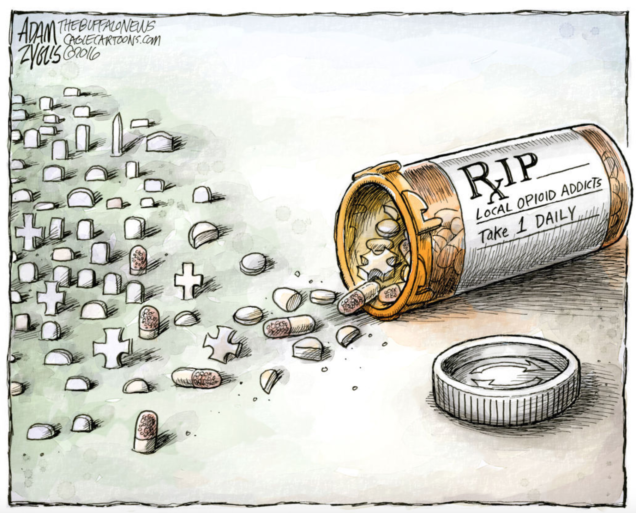America’s Opioid Epidemic

According to the NIH, 90 people in the U.S. die from overdosing on opioids every day. This rise in opioid usage began when a number of different opiate brands, such as Vicodin and Xanax, started being prescribed to more patients of different, usually younger, ages. In 2000, the average age of drug-related deaths was 40; now we are seeing more people in their 20s and 30s die from drug overdoses. The opioid crisis began with prescription opiates but has now culminated in the abuse of prescription drugs and recreational narcotics like heroin. But how has this epidemic taken so many lives? Well, the answer lies in how the brain develops tolerance and addiction to drugs such as opiates.
What happens to your nerves when you take an opiate? Most chemical signals land on receptors in the axon terminal of your nerve cells, which normally work by attaching to chemical signals that excite electrical impulses through your nerves. By taking opiates, those opiate chemical signals land on opioid receptors and inhibit the electrical impulses from ever traveling through the nerve cell.
There are 3 different kinds of opioid receptors – Mu, Kappa, and Delta. The Mu-opiate receptor is the most important in that it is responsible for activating all the symptoms and effects of taking opiates, such as constipation, pain numbing, euphoria, and depression. These opiate receptors are all-encompassing because they affect not only pain pathways but other parts of the brain such as the locus ceruleus, among other regions.
GABAergic receptors are the start of addiction and are located in the midbrain. GABAergic receptors are in charge of switching on or off the pleasure and pain networks of the brain, and opiates shut off these receptors to induce dopamine (the chemical that relieves anxiety and stress) to fill up the receptors. The secretion of dopamine conditions the brain to think that opiates are good for you and creates a tolerance. These GABAergic receptors adapt to the opiates within your body by producing more cyclic AMP to adjust for the inhibition of the electrical impulses in the nerve cells. Following the increase in cyclic AMP, nerve cells fire more electrical impulses, which cause the symptoms associated with withdrawal, such as diarrhea, dysphoria, and anxiety.
With the knowledge of what causes addiction, new research have arisen from this opioid epidemic. The Scripps Research Institute in Florida has developed a new form of opiate that decreases the risk of overdose while still substantially decreasing pain. This new drug decreases the respiratory suppression normally found in analgesia, which is the number one cause of death from overdosing. Another study from the University of Utah found that a compound from marine snails actually blocks pain pathway signals, which could become an alternative in the near future instead of prescription opiates. Another more popular alternative to pain management as well as withdrawal management is the use of medical marijuana. In a pilot study published in Trends in Neurosciences, cannabinoids are seen to decrease withdrawal symptoms by reducing drug cravings and even restored some neurological damage from prolonged drug abuse.
While this epidemic has taken hold of a larger portion of the U.S. than expected, it is only with the help of the researchers, scientists, and doctors that any damage from this opioid epidemic can be repaired.
Writer: Cindy Wu
Sources:
Compound From Marine Snails Provide Alternative to Opioids
Medical Marijuana’s Underexplored Potential For Helping Opioid Addiction
New Painkillers Reduce Overdose Risk
Short Answers to Hard Questions About the Opioid Crisis
How a brain gets hooked on opioids